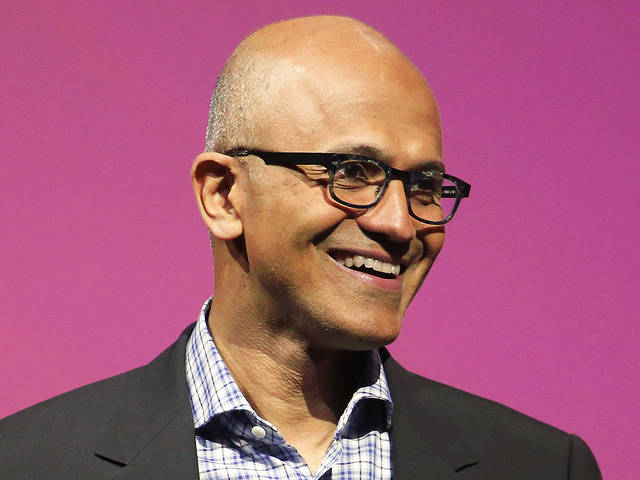Salesforce co-CEO Keith Block knows what your customers are thinking

Last summer, Salesforce promoted chief operating officer Keith Block to co-CEO, putting him on an even keel with Marc Benioff, the company’s legendary founder.
Now Block’s focused on capitalizing on what he calls a “perfect storm of amazing technology disrupting business models and markets,” as artificial intelligence gives companies the ability to achieve what he calls the holy grail of sales software, the chance to know everything about their customers and what they value, no matter how they interact with them.
“Everything for us begins and ends with the customer behind every device, whether it’s a phone or an IT device or a robot,” Block says.
“There’s a customer back there, and you have to have a portfolio that allows you to think about, how do you capture that information? How do you distill that data? How do you make actions through artificial intelligence around better engaging with that customer,” he adds.
Block says that he wants Salesforce to be known as a partner to its customers, as they try to figure out how to capitalize on the rising tide of AI and other emerging technologies.
“We enjoy an incredible relationship with our customers. I think in many ways we’re the envy of the industry in terms of the senior level relationships that we have.”
Share Slide
Stripe CEO Patrick Collison and Stripe president John Collison are opening the world for online business

Stripe famously began with seven lines of code, developed by brothers Patrick and John Collison — a simple tool to let developers accept credit-card payments in their apps.
That simple idea has exploded into one of Silicon Valley’s highest-flying startups, with Patrick as CEO and John as president. In the years since inception, Stripe has expanded its business to include services like fraud detection, debit-card issuing, and point-of-sale software.
“We have the mission of increasing the GDP of the internet, and fortunately we are not running out of things to do there,” John Collison told Business Insider.
The goal, Collison says, is to reduce the many points of frustration that can make it difficult to do business online. That has included programs like Stripe Atlas, which helps young companies automate the process of filing the paperwork to incorporate and open their first bank accounts.
Customers including Amazon, Lyft, and Target use Stripe to power some of their online-payment systems, while Collison highlights that customers including Warby Parker are using the company’s tech to extend into physical retail.
All this has translated into serious buy-in from investors, including Sequoia Capital, Kleiner Perkins, and CapitalG (formerly Google Capital).
Share Slide
Glitch CEO Anil Dash is making it easy (and fun) to write software

In a world where every company is moving to become a technology company, it’s now extra important to keep developers happy and productive.
Enter Glitch, the namesake tool from the company formerly known as Fog Creek Software. The big idea behind Glitch, CEO Anil Dash says, is to give developers both old and new a tool that makes it easy, and maybe even fun, to build web software, solo or in teams.
Developers are the most expensive people on the staff, Dash says: “Their productivity is really valuable, and their comfort is really valuable.”
Glitch comes with a pedigree: Fog Creek Software previously incubated and spun out businesses like popular developer Q&A site Stack Overflow and productivity app Trello (later sold to Atlassian for $425 million).
Dash says that developers at companies including Google and Microsoft are turning to Glitch because it’s an easy way to developers to come up with an idea, build it, and show it to colleagues. Because it has a Google Docs-style shared-code editor, those teams can work together to make changes.
Just as important, Dash adds, it’s a way for programmers to show colleagues in nontechnical roles like marketing or sales an idea and incorporate their feedback. And then it’s simple enough to get them coding too.
Share Slide
Heather Meeker is helping small software startups come up with new ways to compete with Big Tech

Heather Meeker, one of the most prominent open-source licensing lawyers working today, is helping small software startups come up with new ways to compete against the major players.
Last year was a prosperous one for open-source software, from Elastic going public to IBM announcing it would acquire Red Hat for $34 billion. But it was also a turbulent time, with smaller open-source companies taking defensive action against major cloud providers like Amazon Web Services taking their software and selling it — something that’s legally permissible under the rules of open source but that doesn’t sit well with some.
Meeker, a founding portfolio partner at startup investor OSS Capital, advises open-source-software companies, including advice on the limits of their software licenses, and how to form a business model around the free code.
She helped MongoDB create its controversial new license, intended to place limits on the ability of the major cloud providers to use its open-source code. Even amid the turbulence, she says, there’s still a lot of upside in the market for open-source software.
“There’s no doubt that you can make lots of money as an open-source business,” Meeker told Business Insider. “From a business point of view, the business world has given open source its seal of approval.”
Share Slide
Microsoft CEO Satya Nadella is betting the company’s future on AI and augmented reality

In his five years as CEO of Microsoft, Satya Nadella has breathed new life into a company that many thought was well past its prime.
When Nadella came in, Microsoft was still reeling from a string of disasters: Windows 8 was a flop, the Nokia acquisition was a fiasco, and Amazon Web Services had come out of nowhere to pioneer, and then dominate, the market for cloud computing.
Since then Microsoft has doubled down on cloud computing, with rocket-ship businesses like the Office 365 subscription productivity suite and Microsoft Azure cloud platform helping bring the company beyond the Windows PC and into the modern era.
For his next act, Nadella has staked Microsoft’s claim in the worlds of artificial intelligence, edge computing, and augmented reality. The big idea, he has said, is to make all technology smarter, whether that’s a smartphone, an app running in the cloud, or even farming or manufacturing equipment.
“The interaction model going forward is with computers and computing all around us. It’s no longer about being device-first — it’s about putting the human first, and it includes all the devices in their lives,” Nadella said at Mobile World Congress in Barcelona this year.
Share Slide
Amazon Web Services’ Debanjan Saha is taking on the old guard of Silicon Valley
![]()
For a long time, Oracle was the undisputed database king of the tech industry. And then came Amazon Web Services, the massively profitable and market-leading cloud-computing arm of the retail giant.
Debanjan Saha is in charge of one of the fastest-growing services in the history of AWS, a homegrown Amazon database called Aurora that’s giving even mighty Oracle reason to pause.
The success of Aurora “feels great,” he tells us. “When you first launch a service, you don’t know how good it is going to do. I first knew when a customer baked us a cake and sent it to us, saying ‘you saved our business,’ and I thought, maybe this is a good indication.”
Amazon even created a tool that helps Oracle customers ditch their Oracle database and move to Aurora and other kinds of Amazon databases. Companies run their businesses on their databases, and migrating from one to another is no easy task.
Amazon and its databases are bringing a new form of competition to a market. And with Amazon’s culture of fanatical customer support, Aurora has far bigger implications for the enterprise software industry than just being yet another kind of database.
Share Slide
GitLab CEO Sid Sijbrandij is helping programmers work together, no matter where they are

In 2012, Sid Sijbrandij read about a free open-source project that helped developers collaborate called GitLab. He told the developer he was going to take it, put it on the web, and run it as a business — and he got his blessing to do it, no compensation required.
“That’s very open minded and very much the ethics of open source: You don’t owe me anything,” Sijbrandij told Business Insider.
Today, more than 100,000 organizations are using GitLab, he says. And he’s aiming for an IPO in 2020. Sijbrandij built the entire company — 500 employees in 50 countries — with no corporate offices, and every employee, including himself, working remotely.
GitLab has focused its offering on the super-hot DevOps market, a trend around letting programmers release new software features in a constant stream. That requires giving developers special tools for creating, tracking, and monitoring their software, which has been a major focus for GitLab.
By September, around the same time Microsoft bought his biggest competitor, GitHub, for $7.5 billion, GitLab raised a $100 million round at a $1.1 billion valuation, for $146 million total.
Share Slide
Google’s Aparna Sinha is leading the software project that’s quietly shaking up Silicon Valley
![]()
Kubernetes, an open-source-software project that started at Google, has quietly shaken up the cloud-computing scene, making it easier for developers to manage large-scale software applications.
As more companies move to the cloud, its popularity has exploded, and 54% of the Fortune 500 now run at least some of their computing infrastructure on Kubernetes.
Aparna Sinha leads the team running Google Cloud’s Kubernetes business, a cornerstone of the company’s push to unseat the reigning cloud champion Amazon Web Services. Sinha leads Google Kubernetes Engine, a service used to power apps from companies like Spotify and Niantic, the company behind “Pokémon Go.”
She says that Kubernetes still has a lot of ground to cover but that the potential for Kubernetes to be the underpinning layer behind more cloud software is enormous.
“It needs to be able to run all types of applications,” Sinha told Business Insider. “It needs to be able to run in all types of environments. It needs to be easy to run and manage. At the end of the day this is a platform for software development.”
Share Slide
PagerDuty CEO Jennifer Tejada is sounding the alarm when software goes bad

Batman has the Bat-Signal. Silicon Valley engineers have PagerDuty. When trouble calls, PagerDuty’s software alerts the appropriate engineer and gets them the information they need about how to fix it.
In the three years since Jennifer Tejada took over as the CEO of PagerDuty, the company has ridden the wave of DevOps — a portmanteau of “development” and “operations” — which is now one of the most popular concepts in the modern tech industry, helping companies release more software faster by fixing problems as they arise.
PagerDuty filed to go public in March, and had a grand debut on the markets: PagerDuty popped up as high as 50% in its first day of trading, in an IPO that raised over $200 million for the company.
Years ago, VCs wouldn’t have thought of investing in startups for developers, but now, they’re all in on DevOps, thanks to the increasing importance of software to every company.
Share Slide
Slack VP of product Tamar Yehoshua is building a smarter way for people to talk to each other at work

Slack, the IPO-bound workplace chat app last valued at $7 billion, has plans to get smarter, much smarter. And Tamar Yehoshua, who joined the company in January, is the exec who’s working to get it there.
So far, Slack has been best known as a workplace chat room that lets you share files or links to other apps. But it’s working on becoming more of collaboration tool, and just bought the email app Astro. Going forward, all eyes will be on Yehoshua and her team for delivering new products and features.
While she hasn’t had time to make a major mark on Slack yet, Yehoshua is a big name in Silicon Valley. She spent eight years at Google and is best known for leading that’s company mobile search team with innovations like voice search, a technology that understands not just what you said but what you meant to say, and delivers relevant results.
More recently she led engineering teams that worked in areas such as identity, privacy, spam, and abuse. She came to Google from Amazon’s A9 labs, the unit that created Amazon’s search and advertising tech, where she was a director of engineering and a VP of advertising tech.
Share Slide
INTRODUCING: The 10 people transforming the way the technology industry does business

Share Slide


